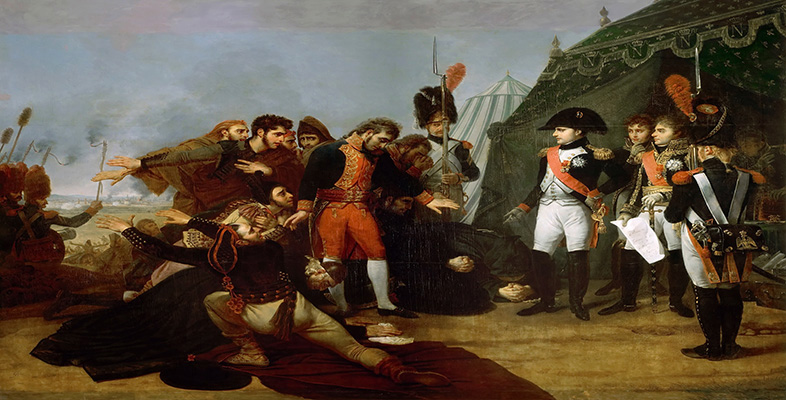3.5 Napoleon Visiting the Field of the Battle of Eylau
Napoleonic propaganda painting was very tightly controlled. In 1806, for example, the list of subjects was devised by Denon in consultation with Napoleon. The exact moment to be depicted was specified in several cases; as the above examples indicate, this could be crucial in ensuring that any too overt representation of violence was avoided. Artists were simply allocated the subject that they were to paint, and were also required to submit sketches of their proposed compositions to Denon for approval. All of the paintings were to be ready for the Salon of 1808, and any artist who did not finish in time was to be ineligible for further commissions. In fact, Gérard and Gros (who was also supposed to depict an episode relating to the battle of Austerlitz) both failed to meet the deadline, but only because they were required to produce other paintings for the regime in the intervening period. In Gros's case, the work in question was Napoleon Visiting the Field of the Battle of Eylau (see Plate 20 [Tip: hold Ctrl and click a link to open it in a new tab. (Hide tip)] ), the commission for which he was awarded in 1807 on winning a competition to commemorate the event.
Click to see plate 4 Antoine-Jean Gros, Napoleon Visiting the Field of the Battle of Eylau, 1808, oil on canvas, 521 x 784 cm, Louvre, Paris. Photo: Bridgeman Art Library
The battle itself took place in Poland, near the village of Eylau, on 7–8 February 1807; the enemy force consisted largely of Russians. It was fought in a howling snowstorm, and the outcome remained uncertain on the morning of the 9th. Napoleon contemplated retreat but, when the Russians did so first, he declared victory even though the French had suffered immense losses. Their casualties may have numbered as many as 30,000, while the Russians’ have been put at up to 25,000. In the 58th Bulletin de la Grande Armee, which was devoted to an account of the battle, however, Napoleon put the figures at 1,900 French killed and 5,700 wounded. The Bulletin was one of the principal propaganda vehicles of the regime, serving to bring reports from the front into French homes. Its role was celebrated in a painting of 1807 by Louis-Leopold Boilly (1761–1845), Reading the ‘Bulletin of the Grande Armee’ (see Plate 20), which shows an entire family caught up in a patriotic fervour; even the breast-feeding mother is fulfilling what Napoleon considered to be women's primary function, that of producing new soldiers for the empire. Note, too, the bust of Napoleon on the mantelpiece, a copy after one made by the Italian sculptor Antonio Canova (1757–1822) (see Plate 21); such copies made Napoleon's image widely known. Of course, Boilly's painting does not correspond to the scepticism that we know actually characterised popular attitudes to reports in the Bulletin.
Click to see plate 20 Louis-Léopold Boilly, Reading the ‘Bulletin of the Grande Armée’, 1807, oil on canvas, 47 x 60 cm, Private Collection/ Agnew's, London. Photo: Bridgeman Art Library
Click to see plate 21 Antonio Canova, Napoleon, 1802, marble. Galleria d’Arte Moderna, Florence. Photo: Bridgeman Art Library
It was in the face of this kind of scepticism and, more specifically, in the face of widespread rumours that French losses were far higher than was admitted in the Bulletin that the imperial propaganda machine launched a campaign to persuade the French people that Eylau had been a great victory. The 58th Bulletin, which was printed in the official newspaper, Le Moniteur, on 24 February 1807, was followed by further bulletins countering reports of catastrophic losses. Since knowledge of what had happened could not be entirely suppressed, the regime needed to manipulate public opinion, and for this purpose official propaganda was less effective than reports that seemed to emanate from objective sources. This is why Napoleon himself dictated an ‘eyewitness’ report of the battle by a German, which appeared in the French press. It was as part of this exercise in damage control that the painting competition was announced by Denon in a letter to the press on 2 April. The logic behind it was that, if Eylau was indeed the victory that the regime claimed it was, then it must be capable of pictorial representation like the battle of Austerlitz. However, the terms of the competition were extremely tight; not only did the announcement include an account of the subject, but the letter also informed artists that a sketch of the site was available for consultation in Denon's offices.
